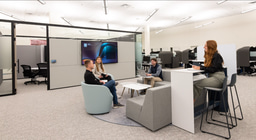CRO - The long-awaited marriage of IT and AV

If you spend as much time as I do on LinkedIn you would have probably noticed a new position that has arisen in the last few months called a “CRO.” To be clear, this is not the Chief Revenue Officer. CRO in this case stands for Chief Remote Officer. That’s right, a C-suite position leading an organization within a company dedicated solely to remote work! This seems all too timely if you ask me. In a way, it is a purely reactive answer to today's post-pandemic workforce. It’s also a much-needed position. A quick Google search yields numbers of up to 22% of today's workers being remote either full or part-time. That’s much more than years past. We know why this position was created, there is a need to manage all of this remote work efficiently and in a way “silo” those efforts to better predict a successful outcome. That is exactly why the first hires into these CRO positions are the most crucial. And, while there are many things that could lead to the success or failure of this position, the most important is to marry the IT and AV departments into a single discipline. Since IT and AV teams are responsible for the employee experience, which includes collaborative tools, and equitable experiences both in and out of the office, if this person doesn’t prioritize a synergy between AV and IT, they will certainly fail. So let’s first define what the world thinks of what a CRO should be and then explain how neglecting this internal partnership will cause this brand-new, shiny organization to crash and burn.
I searched for some open job positions trying to gain some insight from the job description. Of course, this will vary from company to company so here is a general summary of what I found:
- Hiring and training of a remote workforce
- Defining the evaluation of remote workers
- Creating standards for what remote or hybrid work will look like aligned with the company goals
- Prioritizing inclusive and collaborative environments for remote or hybrid employees
This is a great start and as you can see, pretty HR-focused. However, from this list, I think the last bullet point is the most important. But how is this going to happen? How do we create collaborative spaces for folks that could be all over the country or even the world?
First, let's talk about how IT and AV fit in a large organization today.
Traditionally IT teams focus on some of these key areas:
- Asset management of laptops
- Purchasing, delivering, and breaking/fixing
- Software procurement and licensing
- Connectivity options
- Asset management of phones, webcams, headsets, etc.
AV teams, on the other hand, typically have responsibilities such as the following:
- Accessibility (Making sure that equipment and software are intuitive for everyone and being able to provide detailed instructions and training on how to use it)
- Meeting Equity (With everyone looking and sounding different, AV pros play a role in making sure the playing field is as even as possible. This means making sure all levels of voice tones and inflections are heard and the details of any visual are communicated
- Quality of media transmissions (not just delivering the video/audio/image but making sure it doesn’t sound like two tin cans with a string between them)
- Integrating various vendor platforms to create a seamless experience for the employee (think of the many ecosystems that exist and how difficult it can be to get them to function together)
All pretty straightforward so far. So how can the CRO marry these departments and goals and apply them to a remote-focused employee base? Failing to execute on any one of these principles would be a huge miss for any company, so let's dive in.
- Collaborate EARLY
Ironically, the idea of the CRO is really to allow the entire company to collaborate without physical limitations. Using that school of thought, they should take a play from their own playbook and have internal collaboration before any vendors are selected and before any contracts are signed. When IT teams rely on AV for help they put themselves in a position to better serve the employee. This is because of some of the aforementioned responsibilities. Can you imagine how much better of an experience a remote employee would have if the laptop they were given also came with an external webcam that tracked their movement, allowing for better customer presentations? Or if the video stream from that camera was always guaranteed to have the highest possible resolution? Just to name a few examples. And now, instead of just traditional specs like processor speed and hard disk space, we could be concerned with the human element of how a person lives and interacts with a device. Thus making more informed purchasing decisions about our technology. Collaborating early can also prevent the need for clunky integrations with all your disparate ecosystems because the goals are clearly defined by two
2. Ask for feedback often
This can be a tough step because you are basically opening up the suggestion box. And we all know that all feedback isn't necessarily what you want to hear. Especially if you have just invested tens of thousands of dollars into employee equipment and things you are hearing aren't the most positive. That’s okay because this is still a relatively new concept. We are bound to fail at something in one way or another. But it's not okay if we don't use the feedback. It's how we react to the feedback that is most important. Not so surprisingly, there needs to be even more collaboration here. Talk about what’s not working and how it can be improved together.
I can’t help thinking about my own experience during the pandemic here. I remember that webcams (especially high-quality ones) were a hot commodity. So much so that prices were going through the roof and availability was scarce. During this time I received a new laptop. Normally that’s a good thing but this laptop had no camera! I can’t help but think that if our AV department would have been involved with what we were telling the IT folks, we probably would have never been in that position to begin with. The audio-visual folks would have been able to tell them about the latest technology and how the equipment we currently have won’t be good enough. This, I'm sure, would have only led to an increase in productivity and employee satisfaction.
3. Be forward thinking
I know that no one has a magic crystal ball, but IT and AV working together most assuredly have more than enough data between the two of them to make forward-looking decisions look easy. We all know that you can’t solve for the unknown. But what happens if there is another huge shift in the other direction? Meaning, everyone is now going back to the office. How does that look with our current equipment? For instance, can those devices and software work seamlessly in a conference room or does it rely on a completely different ecosystem thus needing to be integrated? Although this is just an example, the questions can certainly be answered now.
Assuming that AV and IT have been applying steps one and two so far, this step can be somewhat painless. Future-proofing is a challenge that every IT and AV have to face on a daily basis. It’s a push and pull of different budgetary, contractual, and business goals and constraints. Do IT and AV share the same goals and restraints? No. But imagine a situation where collectively, the two can sit down and share knowledge about trends and provide predictable data to one another and align on best practices for remote work.
It’s no secret that the union of IT and AV has been a long time coming. The concept of creating a CRO presents an open door for this to happen. I believe we can employ a little artistic freedom here when molding this position. If we take that freedom and marry IT and AV we can not only enhance the remote work experience, but we can also prevent the newly-created position of the CRO from crashing and burning.
Recommended Content
2026 Preview – What Our Experts Anticipate This Year






Please sign in or register for FREE
If you are a registered user on AVIXA Xchange, please sign in
Recently, I just highlighted on these KSA's that AV will have to become more dynamic. AV has been fighting with IT about this shift since, 2008 - well it's here!
Hey Guy, thanks for the comment! I am trying hard to get AV and IT to work together in perfect harmony. Hopefully, roles like this will help the industry shift focus to a more 'personal' AV/IT experience for all!
Indeed!